HIPAA Compliance Checklist for 2025

Some hours feel productive. Most feel busy.
You switch from one tool to another, editing spreadsheets, waiting for approvals, messaging colleagues on Slack, then do it all over again. By the time the day ends, you’ve been busy all day, yet the most important tasks are still unfinished.
That’s when AI productivity tools truly prove their value. Beyond enabling quicker workflows and automating routine processes, these solutions minimize friction, eliminating small interruptions, repetitive steps, and hidden time-wasters that disrupt your momentum.
Research found that AI productivity solutions like Microsoft Copilot helped UK civil servants reclaim almost 26 minutes each day, the equivalent of two extra weeks annually by automating administrative and document-related work.
TL;DR - AI Productivity Apps
A. What are AI Productivity Tools?
AI productivity tools are software that help teams get more done in less time by automating tasks, improving workflows, and speeding up decision-making.
Some help you generate content. Others track project updates, summarize meetings, route approvals, or pull insights from documents. They're designed to cut down the repetitive work that slows teams down, so people can focus on high-impact tasks instead.
You’ll find them across every function: finance, procurement, IT, sales, and marketing. Wherever there’s a process with delays, handoffs, or too many manual steps, AI tools are quietly fixing it.
B. What are the Benefits of Best AI Tools for Productivity?
AI productivity tools from Toolsfine improve efficiency by automating repetitive tasks, streamlining workflows, and supporting better decision-making across teams. They're built to help you save time, reduce errors, and shift your focus to high-impact work instead of routine busywork.
Let’s break down the key ways these tools help teams work smarter.
Increased efficiency and automation
- Task automation: AI can take over tedious tasks like data entry, scheduling, and basic document handling, so your team can stop being bottlenecked by admin work.
- Workflow optimization: Whether you're managing approvals or organizing tasks, AI tools help simplify processes and cut down unnecessary steps.
- Time savings: As mentioned previously, Microsoft Copilot saved 26 minutes per day by automating routine work, adding up to two weeks annually.
Better decision-making with less guesswork
- Data analysis: AI systems can process massive datasets in seconds, helping you spot patterns and get answers fast.
- Predictive insights: Many tools forecast trends or outcomes based on your historical data, useful for everything from budget planning to vendor performance tracking.
- Fewer errors: AI tools from AIDirs helps reduce human error, especially in calculations, report generation, or data analysis.
Improved focus and less burnout
- Task prioritization: The top AI tools for marketing learn your habits and deadlines to help you focus on what’s urgent and ignore the noise.
- Smarter time management: AI can flag time-wasting activities, suggest better schedules, and give reminders so you can stay on track.
- Lighter workloads: When automation handles repetitive work, your team feels less overwhelmed and more productive.
Real cost savings
- Lower labor costs: Fewer manual tasks mean fewer hours spent on routine operations, and fewer people needed to do them.
- Resource optimization: AI can recommend better ways to allocate budget, time, and team effort across departments.
- Avoid rework: With AI catching errors early, teams spend less time fixing mistakes and more time moving forward.
Smoother communication and collaboration
- AI meeting assistants: Some top AI tools for business like Fireflies or Otter auto-summarize calls, flag action items, and sync notes across tools.
- Faster answers: AI chatbots and virtual assistants give teams quick access to data or FAQs without waiting on someone else.
- Cross-team clarity: The top AI software has Built-in translation and summarization features that improve collaboration across locations and roles.
Space for innovation
- Spotting opportunities: Some tools analyze market signals or customer data to highlight trends or gaps you might miss.
- Faster product feedback loops: AI can review customer feedback at scale to help your product and ops teams iterate faster.
- More creative bandwidth: With busywork off their plates, your team can focus on problem-solving and strategy.
C. Top 10 Best AI Productivity Tools
Here’s the list of free AI tools for business:
1. CloudEagle.ai
Best for: Mid-to-large enterprises looking for AI tools for productivity that streamline SaaS management, procurement, and governance across departments.
CloudEagle.ai is one of the most comprehensive AI tools for productivity if you're managing a growing stack of SaaS apps. It helps cut down the time you spend chasing renewals, reconciling contracts, and answering license requests by automating them.
With 500+ direct integrations and an AI assistant called SaaSPilot, CloudEagle.ai turns manual grunt work into smart, automated workflows. Whether it’s approving vendor contracts or reclaiming unused licenses, this tool helps teams do more in less time, without the chaos.
Key Features:
- Remote Work Governance: In distributed setups, tracking tools, access, and spend get messy fast. CloudEagle.ai brings everything into one view, so remote teams stay productive and compliant, no spreadsheets required.

- Zero-Touch Onboarding & Offboarding: IT teams often waste hours manually adding or removing user access, leading to delays, mistakes, and security gaps. CloudEagle.ai automates the entire process, provisioning and deprovisioning users instantly across both SCIM and non-SCIM apps. It reduces manual IT work and eliminates compliance risks.
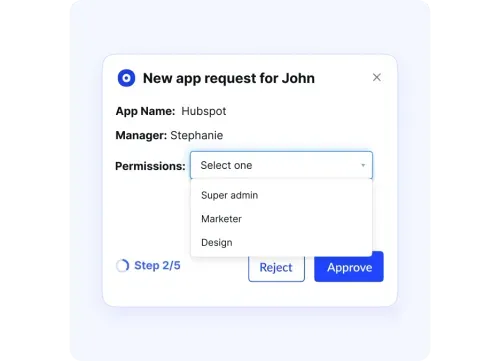
- AI-Powered Contract Management:When contracts are buried in email threads or folders, you miss key clauses and renewal dates. CloudEagle.ai uses AI to auto-extract metadata and organize all SaaS contracts in one place, giving you full visibility and avoiding surprise renewals.
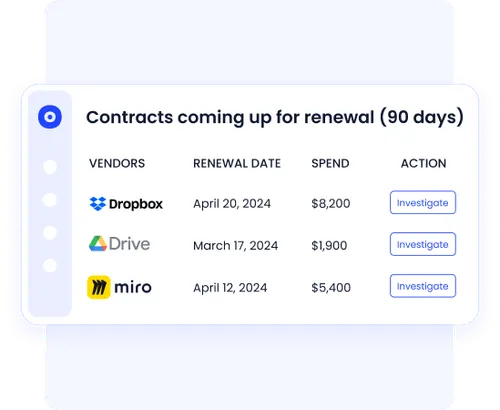
- License Reclamation: Unused licenses silently drain budgets because most teams don’t have a real-time view of app usage. CloudEagle.ai identifies underutilized or duplicate licenses so you can reclaim or cut them, freeing up budget for higher-impact tools.

- Vendor Price Benchmarking: Without pricing benchmarks, you’re negotiating blindly. The platform gives you access to peer pricing data and SaaS buying guides, helping you negotiate with leverage and avoid overpaying.

- Slack-Based Intake & Approval Workflows: Approval requests often get buried in emails, causing delays across departments. With CloudEagle.ai, employees can request apps and track approvals directly in Slack. This accelerates workflows and reduces back-and-forth.
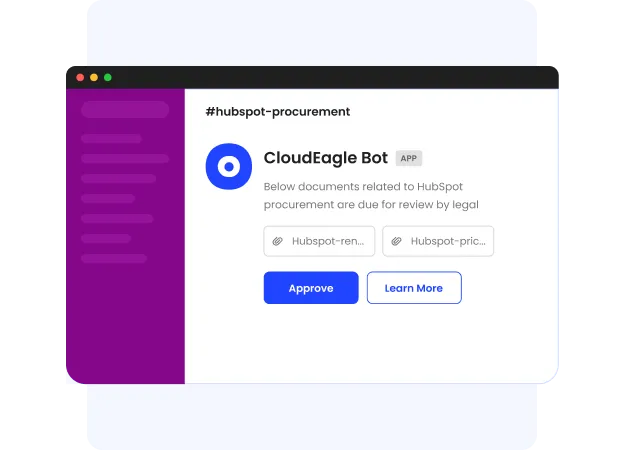
- Self-Service App Catalog with Access Control: Shadow IT is a major compliance and cost issue. CloudEagle’s curated, access-controlled app catalog lets users request tools from a pre-approved list, reducing risk and improving audit readiness.
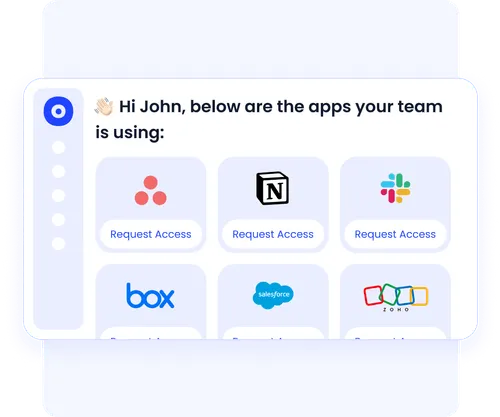
- Spend Analytics & Budget Forecasting: Finance teams get real-time spend visibility, usage trends, and renewal projections, perfect for forecasting budgets and identifying waste.
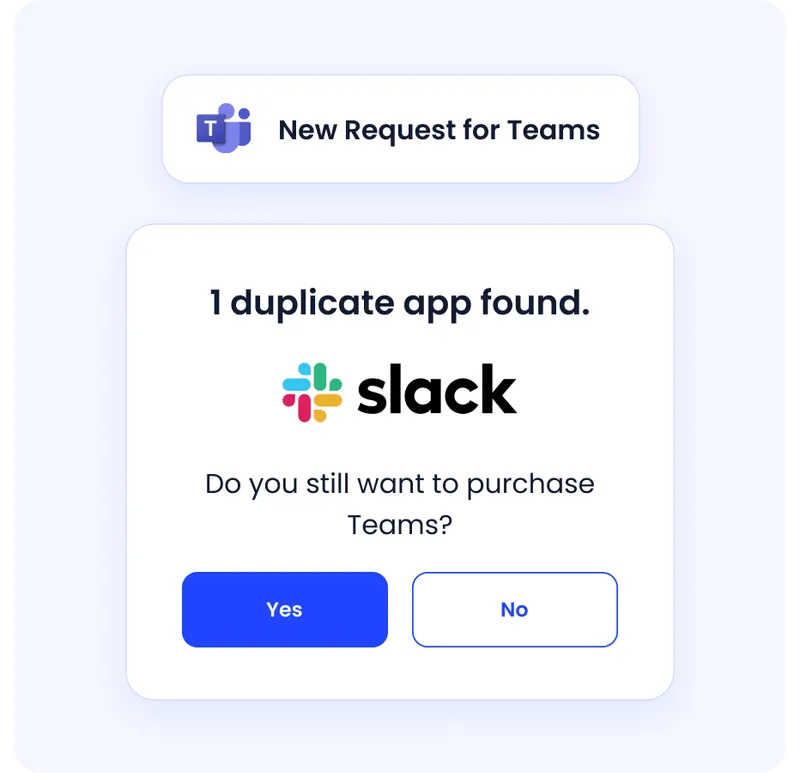
Pros
- Eliminates manual tracking and scattered approvals across IT, Finance, and Procurement
- An AI assistant covers optimization insights you’d miss manually
- Seamlessly integrates with Slack, Coupa, CLMs, help desks, and more
Cons
- Needs a reliable connection: Real-time automation features like SaaSPilot may lag on unstable internet.
- Not for tiny teams: Smaller orgs with low SaaS volume might find it too enterprise-leaning.
- Feature-rich UI: First-time users might need a short learning curve to unlock full productivity gains.
Pricing: Starts at $2,000–$2,500/month, depending on the number of employees and modules selected. Modular pricing ensures you only pay for what you need.
2. ChatGPT
Best for: Teams looking to streamline communication, summarize information, automate content creation, and accelerate internal research across functions like customer support, marketing, operations, and finance.
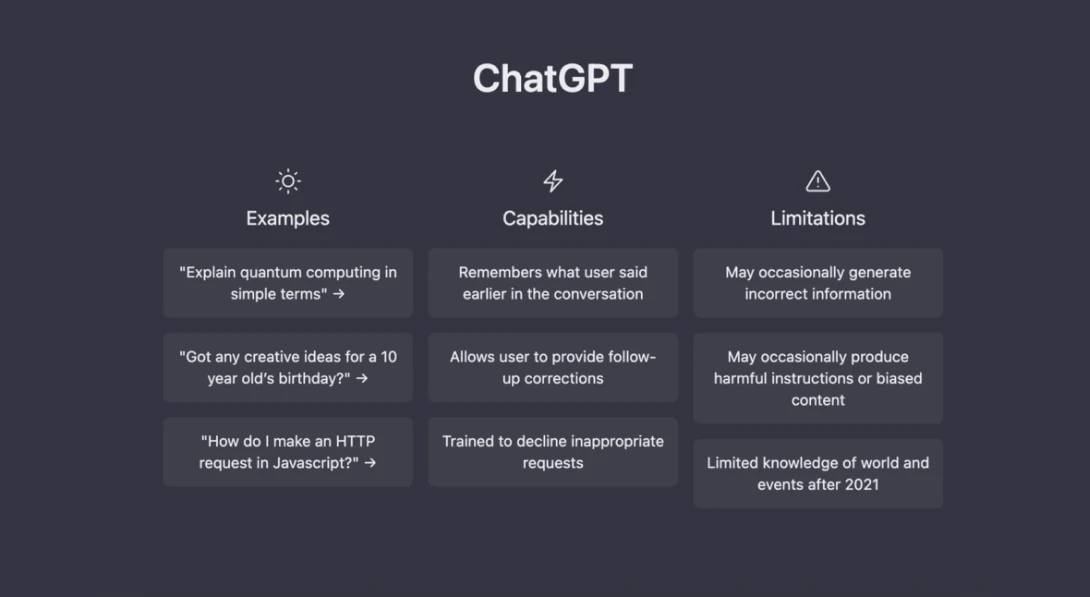
ChatGPT is an AI productivity tool and the best artificial intelligence software developed by OpenAI that uses natural language processing (NLP) to understand and respond to human prompts.
It can answer questions, write emails, create content, brainstorm ideas, summarize docs, and even generate code, saving time across repetitive tasks and creative workflows. With both free and pro versions, it’s accessible and highly customizable through GPTs and API integrations.
Key Features
- Instant Content Creation: Drafting emails, reports, and content takes up more time than most teams realize. ChatGPT helps you generate structured, readable content in seconds based on simple prompts, freeing your team from repetitive writing.
- Summarization & Research Assistant: Reading through long documents, threads, or meeting notes is tedious. ChatGPT can summarize key points or extract answers instantly, acting like your on-call analyst or research buddy.
- Custom GPTs for Specific Use Cases: Every team has unique tasks like support teams, for example, may need pre-filled ticket replies. With GPTs, you can customize ChatGPT to act like a procurement assistant, finance analyst, or customer service agent trained on your data.
- Multi-Step Workflow Automation: Instead of toggling between tools or copying data manually, teams can use ChatGPT with tools like Zapier or Notion AI to trigger workflows like creating task lists from a Slack thread or drafting a renewal email based on CRM data.
Pros
- Free version available with generous capabilities
- Speeds up knowledge retrieval and decision-making
- Customizable for niche workflows via GPTs and plug-ins
Cons
- Requires well-written prompts for best results
- Limited data freshness unless connected to browsing tools
- May need internet access or a stable connection for real-time tasks
Pricing
- Free Plan: Access to GPT-3.5 with basic features
- ChatGPT Plus: $20/month per user for GPT-4, faster response times, custom GPTs, and more advanced features
- Enterprise Pricing: Custom pricing for teams with admin controls, higher API limits, and private deployments
3. Claude
Best for: Teams and individuals looking for a privacy-first AI assistant that excels in writing, coding, reasoning, and structured thinking with a human-like conversational flow.
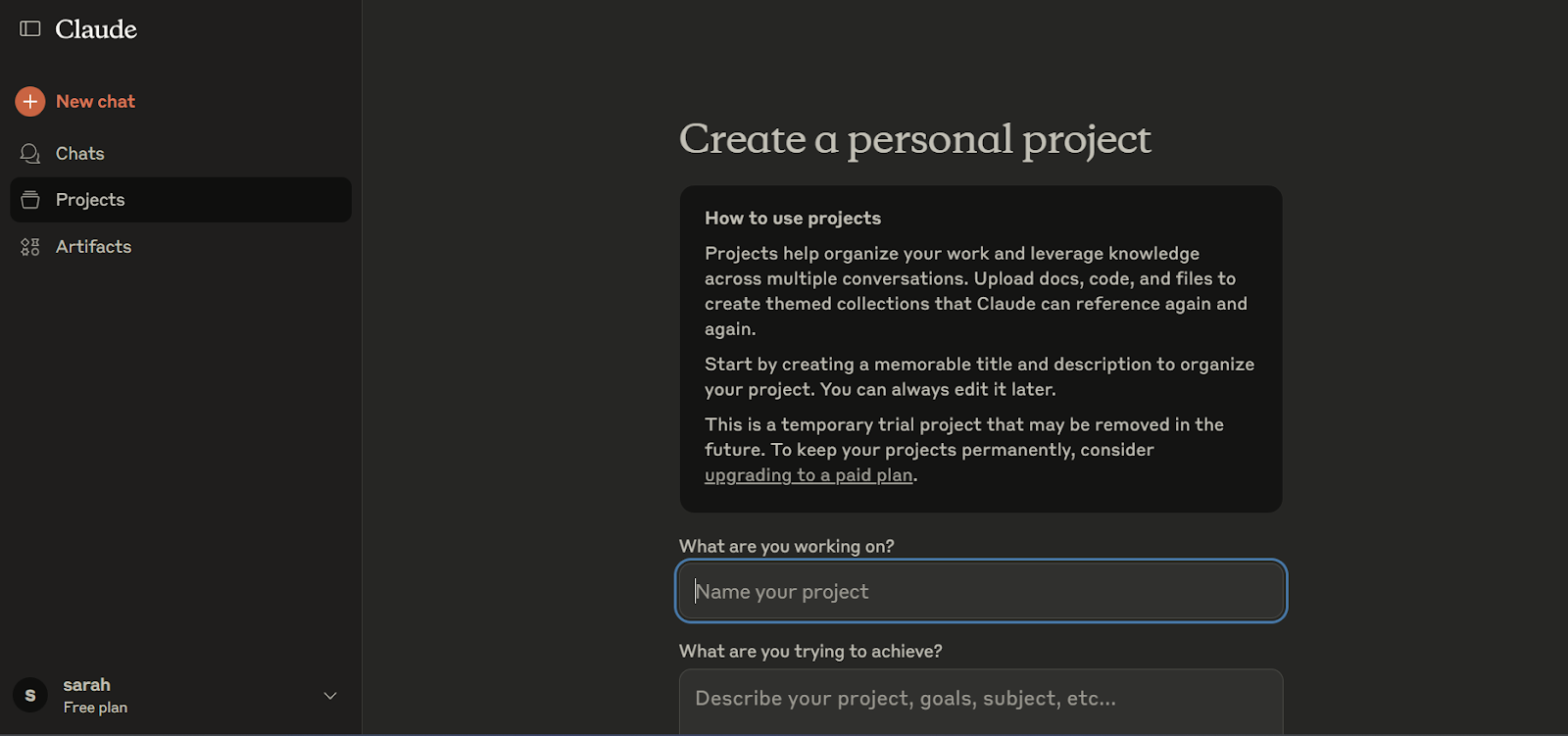
Claude is a next-generation AI assistant by Anthropic, designed to be safe, honest, and helpful. It supports everything from automating content creation and coding to deep research and data visualization. With advanced memory, reasoning capabilities, and hybrid response modes, Claude adapts to various workflows from solo marketers to technical product teams.
Key Features
- High-quality writing & copy generation: Claude’s Sonnet 4.0 model produces more natural, creative, and emotionally intelligent outputs, making it ideal for marketing, product copy, and narrative writing.
- Coding support with structured reasoning: Claude not only writes clean code but also walks you through its logic, helping developers understand and refactor confidently, especially helpful for large-scale monorepos.
- Data visualization & financial analysis: Claude simplifies data-heavy tasks by generating meaningful tables, graphs, and breakdowns, helping marketers and analysts visualize business performance with ease.
- Memory API & project organization: Claude’s memory API remembers domain-specific knowledge across sessions and lets you organize chats, notes, and docs under unlimited “Projects.”
- Enterprise-grade security & compliance: Claude comes with ASL-3 safety layers, audit logs, and regional data storage, satisfying ISO 27001, SOC 2, and privacy-conscious teams.
Pros
- More creative, emotionally aware writing than most LLMs
- Extremely helpful for brainstorming, strategy, and long-form content
- Excellent coding support with reasoning and explanations
Cons
- More expensive than competitors like ChatGPT and Gemini
- Usage limitations can trigger delays during long sessions
- Sometimes verbose and needs precise prompting to stay on track
Pricing
- Free: Access Claude on web, iOS, Android with limited usage
- Pro ($17/month billed annually): More usage, unlimited Projects, Claude Code, Google Workspace integration
- Max (from $100/month): 5x–20x Pro usage, higher task limits, early feature access, priority at peak times
- Enterprise: Custom pricing for large teams and compliance needs
4. Notion
Best for: All-in-one workspace productivity: writing, organizing, brainstorming, and task management with built-in AI.
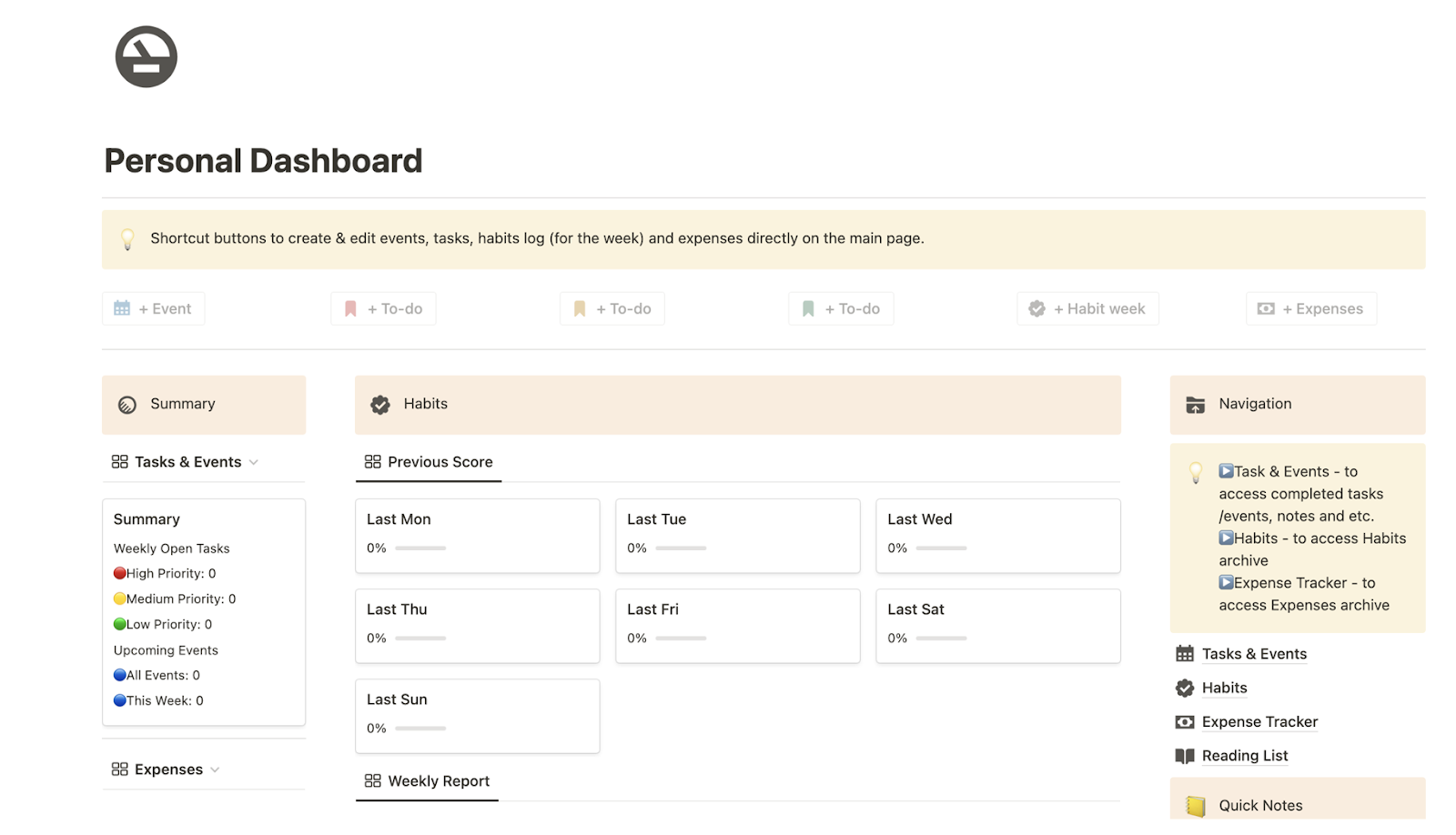
Notion AI blends traditional productivity tools with smart AI assistance. It helps teams and individuals write faster, summarize docs, brainstorm ideas, automate tasks, and organize content, all within the familiar Notion workspace.
Key Features:
1. AI-Powered Writing Assistant: Notion AI helps generate outlines, emails, blog posts, and even full-length documents directly inside your Notion pages, eliminating context-switching and speeding up workflows.
2. Instant Summarization & Action Items: Summarize entire pages or long meeting notes into concise summaries and to-dos with a single prompt, helping users quickly act on what matters.
3. Idea Brainstorming & Q&A: Use Notion AI to brainstorm ideas, answer questions from docs, or generate fresh angles on a topic. It acts like a second brain embedded in your notes.
4. Auto-fill & Editing Help: Notion AI can complete sentences, translate text, fix grammar, and change tone, all in seconds, keeping your content polished without manual edits.
Pros:
- Fully integrated within Notion’s UI, no need for extra tools
- Strong customization with templates and AI blocks
- Works across teams: marketing, HR, product, and personal productivity
Cons:
- Requires paid Notion plan for AI access
- Can be slow with large databases or content-heavy pages
- Not as advanced for domain-specific tasks (e.g., coding, legal)
Pricing:
- Notion AI add-on: $8/user/month (billed annually)
- Requires a Notion Plus or Business plan
- Free trial available
5. Fireflies AI
Best for: Teams that want to automate meeting notes, streamline action items, and reduce manual follow-ups across departments.
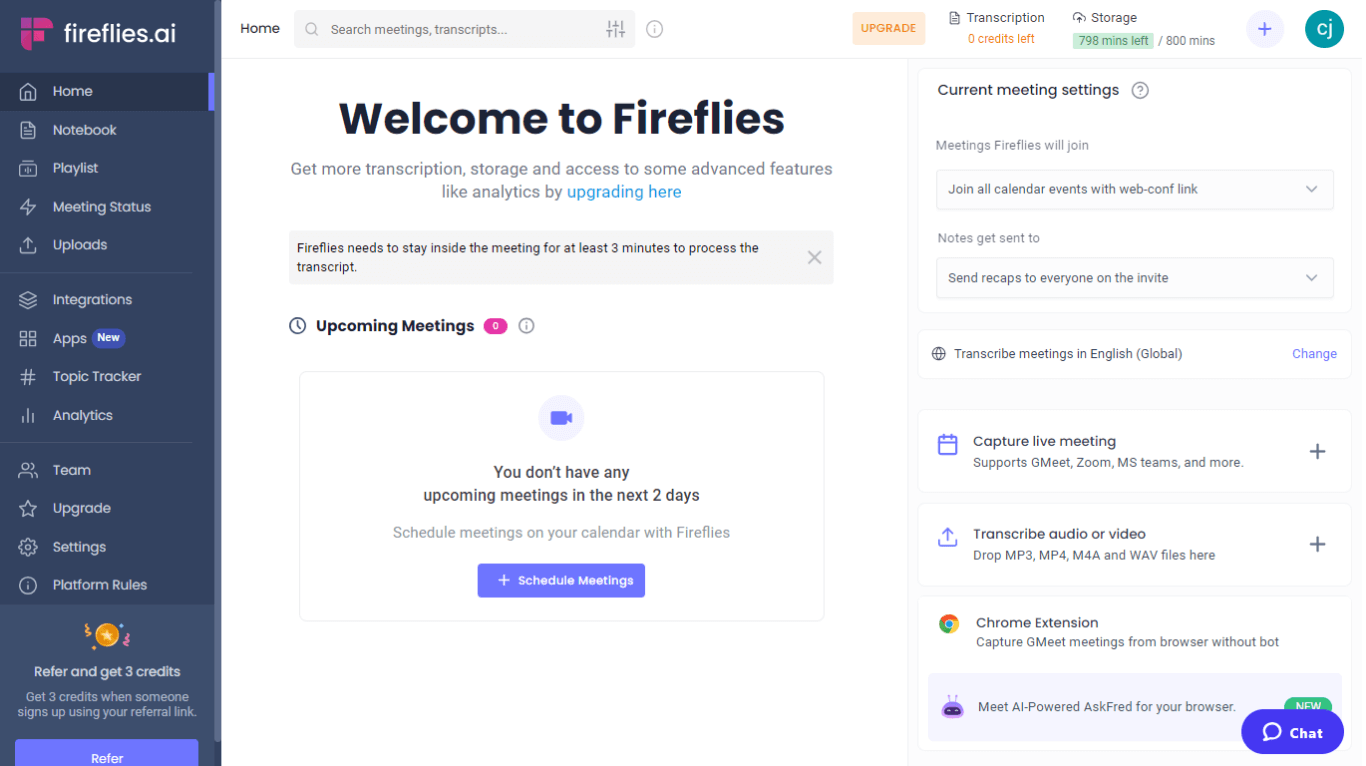
Fireflies AI is an AI-powered meeting assistant that records, transcribes, summarizes, and analyzes your voice conversations. It eliminates the need for manual note-taking and makes every meeting searchable.
Whether it's Zoom, Google Meet, or Microsoft Teams, Fireflies lets you focus on the conversation while it handles the documentation behind the scenes. It's one of the most practical AI tools for productivity when you're looking to speed up follow-ups and improve alignment across remote or hybrid teams.
Key Features
- Automatic meeting transcription: Fireflies automatically transcribes meetings in real time, ensuring every word is captured without distraction. You get full transcripts within minutes after the call, no scribbling required.
- AI-powered summarization: Fireflies delivers auto-summarized recaps with key topics, action items, and decisions, so your team can stay aligned without rewatching an hour-long meeting.
- Speaker detection and searchable notes: Fireflies tags speakers and breaks down transcripts by topic, making it easy to search and pinpoint important moments instantly.
- CRM and collaboration integrations: Fireflies integrates with CRMs like Salesforce and collaboration tools like Slack, making it seamless to push notes, action items, and customer insights where your team actually works.
Pros:
- Transcripts and recaps in minutes, no more forgetting key points.
- Searchable meeting records help save time and resolve disputes.
- Works across popular meeting platforms and CRMs.
Cons:
- Summaries may miss context in very technical or multi-speaker meetings.
- Requires consistent audio quality for best transcription results.
- Transcription credits may be limited in the free plan, not ideal for high-volume users.
Pricing
- Free Plan: Limited transcription credits with access to basic features
- Pro Plan: Starts at $10/user/month
- Business Plan: $19/user/month (includes AI summaries, integrations, and analytics)
- Enterprise: Custom pricing based on advanced features and volume needs
6. Clay
Best for: Teams that want to automate prospect research, personalize outreach at scale, and turn any workflow into an AI-powered one, without writing code.

Clay is an AI-powered data enrichment and automation platform built for modern teams. It combines data from 50+ sources (like LinkedIn, Apollo, and Clearbit) with ChatGPT workflows so you can build personalized lead lists, write outreach messages, or enrich any spreadsheet, all in one place. No scraping, no manual updates.
Key Features:
- AI + 50+ Data Sources: Manually stitching together data from LinkedIn, company websites, and CRMs wastes hours. Clay pulls from dozens of sources in one click and enriches your tables instantly. Think of it like a smart spreadsheet that knows where to look.
- ChatGPT Workflows: Rewriting bios, summarizing customer insights, or crafting first-touch emails? Clay lets you layer ChatGPT onto any column of data. No more copying data into ChatGPT and back; everything updates in the sheet automatically.
- Drag-and-Drop Automations: Most automation tools require a steep learning curve or code. Clay lets you build advanced automations visually, no devs required. From lead gen to pipeline cleanup, it’s built to move with your team.
Pros:
- Saves hours on manual research and copy-paste work
- Seamless ChatGPT integration within your spreadsheet
- Scales outreach and lead gen without extra headcount
Cons:
- Might lag on slower connections due to heavy data loads
- Can feel overwhelming at first due to its flexibility
- Most powerful when used with premium data integrations
Pricing:
Free plan available. Paid plans start at $149/month, depending on data usage and team size.
7. Gumloop
Best for: No-code teams looking to automate complex AI workflows, web scraping, or marketing processes, all without writing a single line of code.
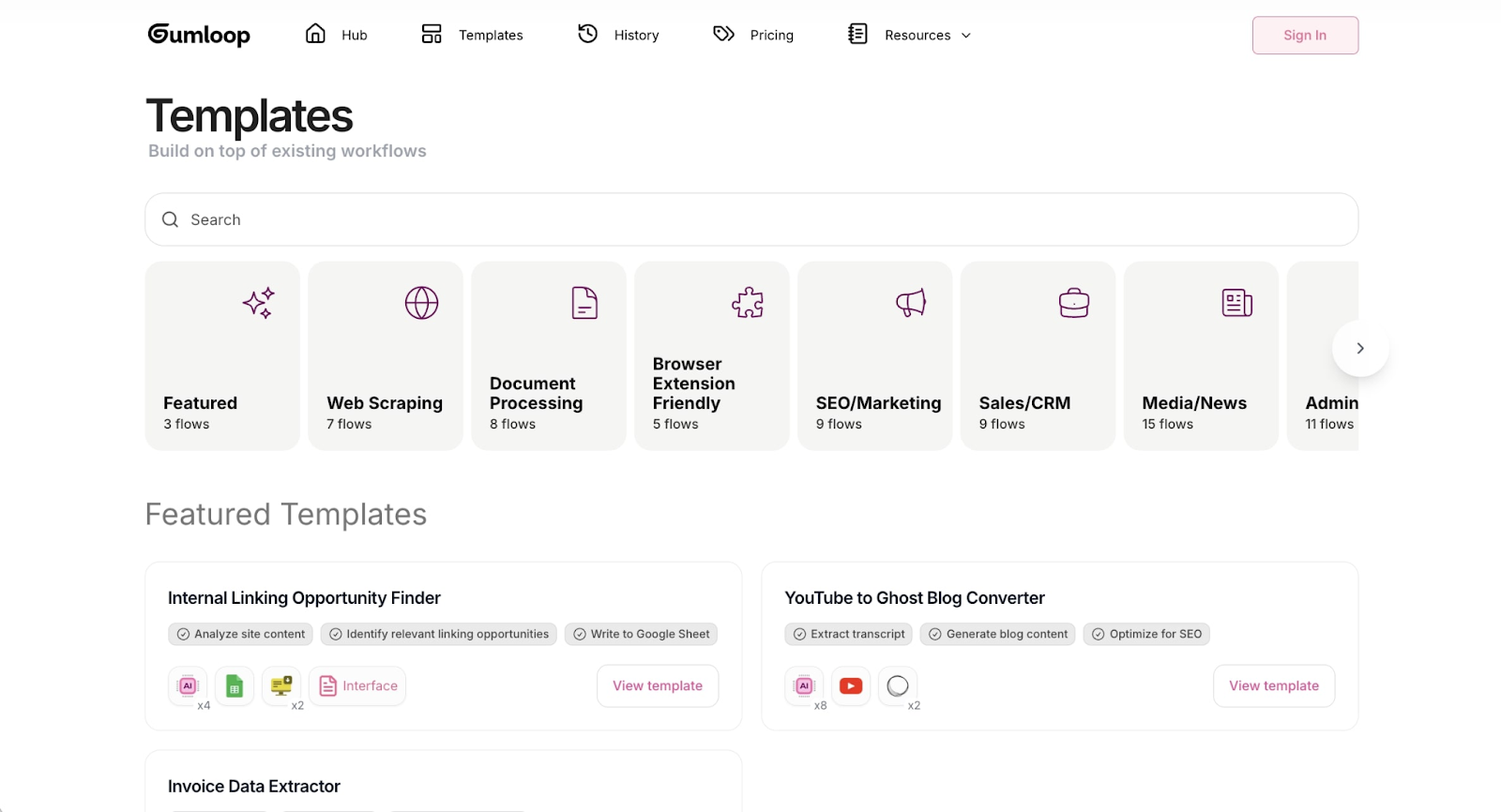
Gumloop is a visual AI automation platform that turns tedious workflows into powerful, hands-free processes. From SEO research and social media calendars to AI content rewriting and document processing, Gumloop helps teams build scalable automation using drag-and-drop logic.
With 50+ integrations and native support for top LLMs like GPT-4, Claude, and Gemini, it’s the go-to platform for teams that need to move fast.
Key Features:
- Drag-and-drop workflow builder: Most teams rely on engineers to automate tasks. Gumloop eliminates that dependency. You can build end-to-end flows like scraping LinkedIn data, rewriting blogs, or setting Slack alerts visually, without touching code.
- Out-of-the-box AI nodes: Tasks like extracting content from a website or summarizing customer tickets are usually done manually. Gumloop gives you pre-built AI nodes for things like tone adjustment, SEO audits, and data extraction, ready to use on day one.
- Trigger-based execution: Running workflows manually slows things down. Gumloop lets you auto-trigger flows via email, Slack, webhooks, or calendar events, making it fully autonomous once deployed.
- Massive parallel execution: Many tools run tasks sequentially, which makes large-scale automation sluggish. Gumloop processes millions of steps in parallel, helping your team go 10x faster.
- Enterprise-ready security: AI automation often raises compliance flags. Gumloop comes fully compliant with SOC 2 Type 2 and GDPR, offers role-based access control, and lets enterprise users set custom data retention and audit logging.
Pros:
- Truly no-code: anyone can build advanced AI workflows
- Handles both small automations and enterprise-scale flows
- Supports a wide range of integrations, from Slack to Semrush
Cons:
- It can feel overwhelming with too many nodes for beginners
- Heavy flows may lag on lower-end machines
- Best features (like role-based access) are gated behind enterprise plans
Pricing:
- Free ($0/month): 1,000 credits, 5 concurrent runs, basic features
- Starter ($97/month): 30,000 credits, 1 seat, low-priority support
- Pro ($297/month): 75,000 credits, 10 seats, Slack support, workspaces
- Enterprise (Custom): Unlimited credits, role-based access, SAML/SCIM, 24/7 support
8. SonarQube
Best for: Engineering teams who want to continuously inspect code quality, detect bugs, and enforce security standards in CI/CD pipelines.

SonarQube is a static code analysis tool that helps developers detect code smells, bugs, and security vulnerabilities early in the development lifecycle. It supports over 30 programming languages and integrates seamlessly into CI/CD workflows to automate code quality checks, helping teams maintain high standards across every commit.
Key Features:
- Static code analysis: Manually reviewing large codebases for bugs is tedious and error-prone. SonarQube automatically scans your code for bugs, code smells, and security issues with every commit, giving your team immediate feedback to improve code quality before merging.
- Security Vulnerability Detection: Security risks often go unnoticed until they’re exploited. SonarQube identifies known OWASP Top 10 and CWE vulnerabilities, helping your devs fix them early. It’s a preventive security layer that fits right into your DevSecOps workflow.
- Technical Debt Management: Poorly written or outdated code slows teams down. SonarQube calculates technical debt and provides actionable recommendations to reduce it, so your team spends more time building and less time refactoring.
- Quality Gates for CI/CD: Releases shouldn't depend on manual QA gates. SonarQube enforces “Quality Gates” in your pipelines, automatically blocking code that doesn’t meet pre-defined standards, keeping low-quality code out of production.
- Multi-Language Support: Most teams don’t write in just one language. SonarQube supports Java, Python, JavaScript, C#, Go, and more, making it ideal for polyglot environments where code quality standards must stay consistent.
Pros
- Helps catch bugs and security issues early in the dev lifecycle
- Seamless integration with GitHub, GitLab, Bitbucket, Jenkins, and Azure DevOps
- Highly customizable rulesets for enterprise-grade code enforcement
Cons
- Initial setup and rule configuration can be time-consuming
- UI may feel dated compared to modern SaaS tools
- Advanced features are locked behind paid tiers
Pricing
- Community Edition: Free (limited features, ideal for hobby projects)
- Developer Edition: Starts at $150/year per instance
- Enterprise Edition: Custom pricing (includes advanced governance, reporting, etc.)
- Data Center Edition: Scalable, high availability, custom pricing for large orgs
9. Gemini AI
Best for: Teams that want Google-powered AI assistance for content creation, coding, research, and productivity, all tightly integrated with Google Workspace.

Gemini is Google’s AI assistant designed to boost productivity across everyday tasks. Whether you’re drafting content, analyzing data, generating code, or researching topics, Gemini acts like a real-time collaborator that understands context and works seamlessly within apps like Gmail, Docs, Sheets, and more. It's especially helpful for teams already embedded in the Google ecosystem.
Key Features
- Deep Google Workspace Integration: Gemini works natively within Gmail, Docs, Sheets, and Slides, letting you generate emails, rewrite documents, analyze spreadsheets, or create presentations without switching tabs.
- AI-Powered Code Assistance: Gemini offers contextual code suggestions, helps fix bugs, and explains code snippets right inside your IDE, speeding up your dev cycle and boosting confidence.
- Smart Summarization and Research: Gemini can summarize lengthy content, extract key insights, or answer questions based on context, helping teams make decisions faster.
- Multimodal Input Handling: Gemini can understand images, audio, and text together, enabling richer interactions and more accurate outputs, whether you're analyzing a chart or drafting creative content.
Pros:
- Seamless experience for Google Workspace users
- Strong summarization and reasoning capabilities
- Real-time contextual suggestions for writing and code
Cons:
- Limited functionality outside Google ecosystem
- May lag behind competitors in creative generation
- Premium features gated behind paid plans
Pricing
- Free: Access Gemini with limited features via Google Workspace
- Gemini for Workspace (Business/Enterprise): Starts from $10–$30/user/month, varies by plan
- Gemini Advanced: Included with Google One AI Premium Plan ($19.99/month)
- IDE integration and Pro coding tools: Access through Gemini for Developers (pricing bundled)
10. Clueso
Best for: Remote-first teams, async collaboration, and anyone who wants to replace long emails or meetings with quick screen and video updates.
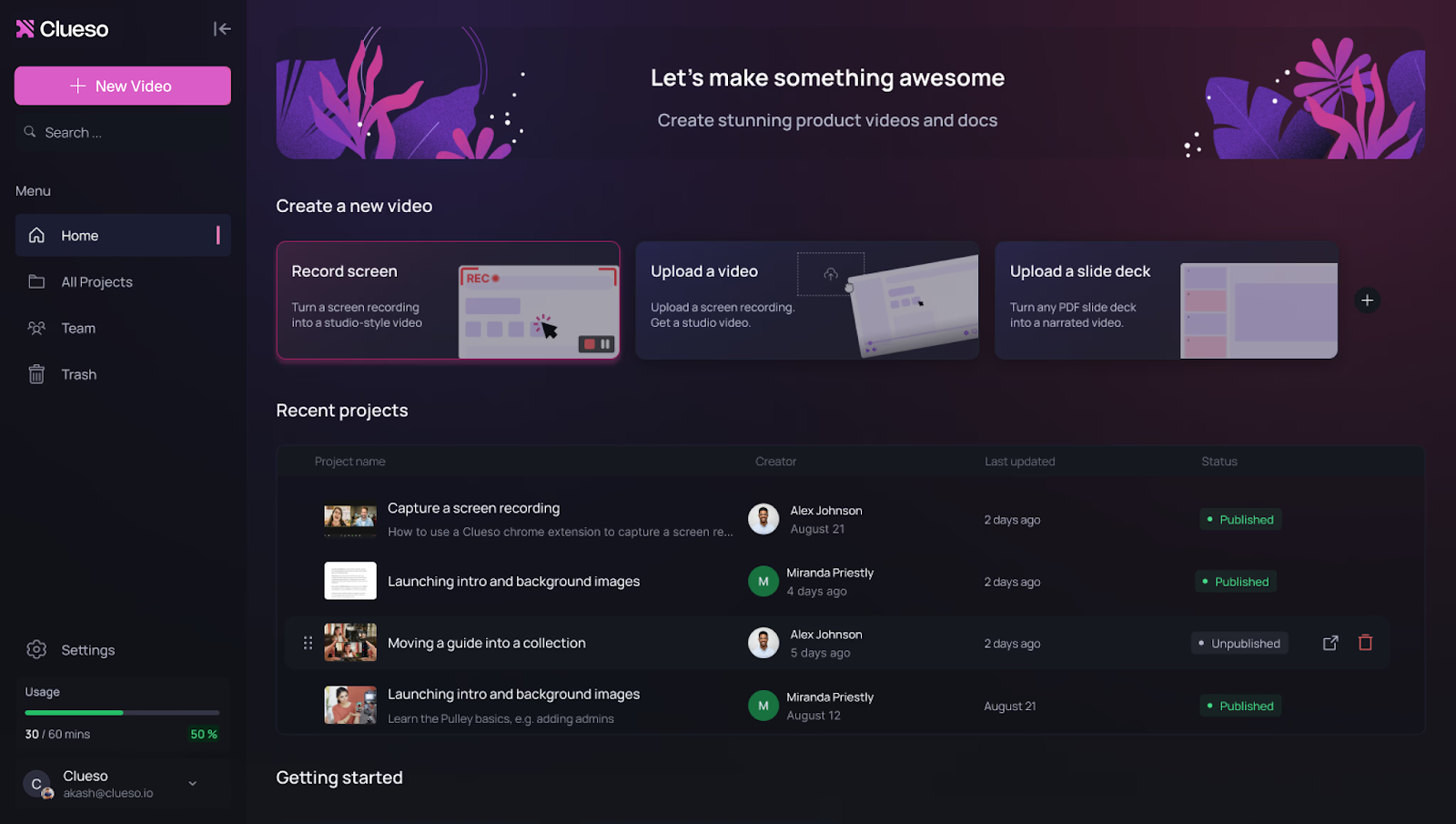
Clueso is an async video messaging tool that lets you record your screen, voice, and face to explain ideas more clearly. It helps teams save meeting time by allowing users to create and share context-rich updates, walkthroughs, and feedback via video instead of live calls. You can also use tools like Fast Wan to generate videos using AI.
Key Features
- Instant Video Recording with Screen + Camera: Clueso lets you record your screen and camera in a few clicks, creating clear and concise video messages that replace meetings and reduce back-and-forth.
- AI-Powered Summarization and Transcripts: Clueso generates AI summaries and searchable transcripts, so viewers can quickly grasp the point without watching the whole clip.
- Slack and Notion Integrations: With deep integrations, Clueso videos can be shared, tracked, and embedded directly in Slack threads, Notion docs, or project tools, keeping updates visible and organized.
Pros
- Simple, clean UI for quick video creation
- Great for async onboarding and project updates
- Built-in AI summaries save viewing time
Cons
- Limited editing features post-recording
- May need a higher-tier plan for team analytics
- Not ideal for live collaboration
Pricing
- Free plan with limited storage
- Paid plans start around $10–15/user/month
- Offers team features and priority support on higher tiers
- Custom enterprise pricing available on request
D. What Are the Challenges of AI Productivity Tools?
AI productivity tools promise speed, automation, and smarter workflows. But adopting them isn’t always smooth sailing. Here are the most common challenges you’ll likely face, and why they matter:
1. Data Security And Privacy Risks
Most AI tools need access to sensitive business data, think documents, customer info, internal chats. That means there’s always a risk of exposure, breaches, or compliance gaps if the tool mishandles or stores data insecurely.
How to handle it:
→ Choose tools that are SOC 2 or GDPR compliant
→ Ask how your data is stored, processed, and shared
→ Keep humans in the loop when handling confidential data
2. Lack of In-house Expertise
AI platforms often sound easy, until your team struggles to configure workflows, tune models, or just interpret results. Without the right skills, adoption slows and ROI drops.
Fix it with:
→ Practical onboarding, not just tutorials
→ Upskilling team members in prompt writing and logic
→ Partnering with vendors who offer solid support or training
3. Bias And Ethical Concerns
AI tools only know what they’re trained on. So if the training data is flawed or biased, you’ll get biased outputs, especially risky in HR, finance, or decision-making tools.
What helps:
→ Use AI tools that explain their outputs
→ Regularly audit automated recommendations
→ Keep final decisions with humans, not algorithms
4. Poor Integration With Your Tech Stack
If the AI tool doesn’t connect well with your existing apps, such as Slack, Notion, CRM, and calendar, it just becomes another silo. That kills efficiency instead of boosting it.
Make it work by:
→ Choosing tools with wide native integrations or open APIs
→ Using middleware like Zapier, Make, or custom scripts
→ Starting with a single use case, then expanding
5. Resistance To Change
Even if the tool is powerful, employees might hesitate. They could fear job loss, hate new workflows, or just not trust the tool. Without buy-in, AI adoption fizzles out.
Overcome it by:
→ Framing AI as a co-pilot, not a replacement
→ Celebrating early wins (like “saved 8 hours this week”)
→ Involving users early in the rollout and testing
6. High Cost, Especially Upfront
Enterprise-grade AI platforms often come with pricey licenses, compute cloud costs, and onboarding fees. For small teams, the ROI might not be immediate.
What works instead:
→ Start with free or pay-as-you-go plans
→ Focus on time-saving use cases with clear ROI
→ Use open-source or low-code tools when possible
7. Creativity And Context Limitations
AI is great at structured, repetitive work, but weak at original thinking or emotional nuance. It might draft an email, but it won’t know your brand tone or office politics.
Solution:
→ Use AI for first drafts, humans for final edits
→ Avoid full automation for nuanced decisions
→ Use prompt frameworks that inject context intentionally
E. How to Choose the Right AI Tools for Productivity?
Selecting the ideal AI productivity tools goes beyond just comparing basic features; it's about ensuring each solution aligns with your unique enterprise goals, team needs, and existing workflows. To maximize the benefits of AI in your organization, consider the specific tasks you want to automate, the compatibility with your current tech stack, and how easily your team can adopt and scale the tool.
Here’s a simple checklist to help you evaluate and choose the smartest option:
1. Start With Your Goals
→ What’s slowing you down: repetitive tasks, poor time management, messy data?
→ Define what “productivity” means for you: time saved, fewer errors, faster decisions?
2. Match Features To Real Problems
→ Look for tools that solve your exact use cases (not just generic automation).
→ Prioritize solutions with explainable AI, task-specific features, or real-time support.
3. Check Integrations And Scalability
→ Can it plug into your current stack like Slack, Notion, CRMs, or calendars?
→ Will it scale across your team or department without breaking workflows?
4. Test Usability, Not Just Tech
→ A beautiful dashboard means nothing if your team can’t use it.
→ Look for minimal learning curves, good documentation, and responsive support.
5. Balance Cost And ROI
→ Is it a flat rate, usage-based, or seat-based pricing?
→ Don’t just chase the cheapest; invest in tools that actually move the needle.
6. Don’t Ignore Privacy And Security
→ Make sure it’s compliant (GDPR, SOC 2, etc.) and transparent about data usage.
→ Avoid tools that use your data to train public models unless explicitly needed.
7. Vet The Vendor
→ Check reviews, case studies, and the product roadmap.
→ Great AI tools come from teams that ship updates fast and support users well.
F. How much do AI productivity tools cost?
The pricing of AI productivity tools for enterprises can differ widely based on several key factors. Gaining insight into these cost structures is crucial for choosing the most suitable solution for your business needs.
- General Price Range: Most enterprise AI productivity tools cost between $10–$100 per user each month, with pricing varying based on features offered and deployment scale.
- Key Pricing Influencers:
- Team size: Larger teams may receive volume-based discounts.
- Integration complexity: Tools that integrate seamlessly with existing enterprise systems or offer custom integrations may command higher prices.
- Advanced automation capabilities: More sophisticated AI automation or analytics features often lead to higher pricing tiers.
- Support levels: Enhanced customer support, dedicated account managers, or premium onboarding can influence total cost.
- Pricing Structure: Most vendors use tiered pricing models, offering significant enterprise discounts and custom packages for larger organizations.
FAQs
1. What are the 4 types of AI tools?
Reactive machines, limited memory, theory of mind, and self-aware AI. Most tools today use limited memory AI that learns from data to automate tasks, enhance decision-making, and improve efficiency.
2. How can AI maximize productivity?
AI boosts productivity by automating repetitive tasks, analyzing data for smarter decisions, optimizing workflows, and reducing errors, freeing up time for strategic, high-impact work.
3. Is ChatGPT a productivity tool?
Yes. ChatGPT helps with writing, brainstorming, coding, summarizing, and more, making it a versatile AI assistant for professionals, students, marketers, and teams across industries.
4. How does AI automate tasks?
AI automates tasks by using machine learning to detect patterns and follow rules. It can handle emails, reports, data entry, meeting notes, and scheduling with minimal human input.
5. Which is the most intelligent AI tool?
There’s no single “most intelligent” tool; it depends on your use case. ChatGPT, Claude, Gemini, and Copilot lead in language tasks, while tools like CloudEagle.ai excel at SaaS productivity.
.avif)
%201.svg)







.avif)




.avif)
.avif)




.png)









